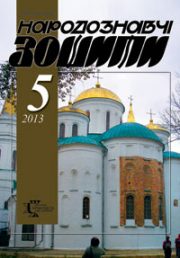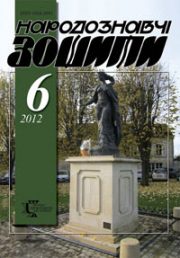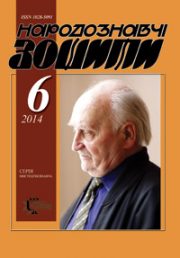2024 #3 Movna U.
The Ethnology Notebooks. 2024. № 3 (177), 584—595
UDK 638.1:070](477.8)”1923/1939″
DOI https://doi.org/10.15407/nz2024.03.584
MOVNA Ulyana
- Doctor of Sciences of History, Leading Researcher
- of the Institute of Ethnology of the National Academy
- of Sciences of Ukraine,
- in the Department of Historical Ethnology,
- 15, Svobody Avenue, 79000, Lviv, Ukraine,
- Contacts: e-mail: movlana@ukr.net
Abstract. This article is the third in the author’s cycle of publications devoted to various aspects of the life and creative path of the famous Ukrainian beekeeper, scientist and public figure Mykhailo Borovsky (1891—1989).
It collected, systematized and researched his research on beekeeping content, which determine the strategy of the development of the industry and give practical recommendations for the rationalization and modernization of the traditional peasant beekeeping economy, scattered in the usual annual and economic calendars of Mukachevo, Uzhgorod and Lviv (1923—1939).
The beekeeping content of the pen M. Borovsky is subject to a detailed research analysis, included on the pages of the calendars «Gromada», «Prosvita», «Zolotyi Kolos», and above all the illustrated business calendar «Silskyi Gospodar» in the section «Beekeeping», for which M. Borovsky was a regular contributor — at that time, the referent of the Main Beekeeping Section of the regional economic society «Silskyi Gospodar» (reestablished in 1928), a member of the board of the beekeeping cooperative «Rij», editor of agricultural periodicals («Ukrainian Beekeeper», «Practical Gardening», illustrated economic calendar «Village Master» for 1933—1935, etc.).
There are practically no special studies of this side of the multifaceted creative activity of M. Borovsky in Ukraine, which determines the relevance of this investigation.
The object of the study is the actual figure of M. Borovsky, and the subject is his publications on the field of beekeeping in numerous calendars of Transcarpathia and Galicia.
In terms of content, they were of a scientific and popular nature, and were aimed at the development of the author’s modern economic thought, the creation of modern beekeeping, the consolidation of the beekeeping community, and therefore, the intellectual and cultural independence of Ukrainians as an ethnic community in conditions of statelessness.
The article uses a historiographic research approach, a comparative method, a method of historical reconstruction.
Keywords: Mykhailo Borovsky, beekeeping, calendar, «Silskyi Gospodar» society, beehives, honey, Ukrainian.
Received 29.04.2024
REFERENCES
- Movna, U. (2021). Mykhailo Borovsky (1891—1989) in the service of Ukraine: the path from a soldier of the Ukrainian People’s Republic to an activist of the beekeeping cooperative movement and a scientist. Ethnology notebooks, 4, 831—839 [in Ukrainian].
- Movna, U. (2023). Book publishing projects of Mykhailo Borovsky on the field of beekeeping (Lviv, 1930s). Ethnology notebooks, 1, 84—94 [in Ukrainian].
- Golyk, R. (2014). Real and reflected Galicia: calendars, time, mentality and everyday life of Galicians in the region and in emigration (end of the XIX — first half of the XX centuries. Bulletin of Lviv University. Series of bibliography, library science and information technologies, 9, 23—42 [in Ukrainian].
- Peredуriy, V. (1999). Historical calendar-almanac of «Chervona Kalyna» as a type of periodical publication (1921—1929). Collection of works of the Scientific Research Center of Periodicals, 6, 226—241 [in Ukrainian].
- Dzvinchuk, O. (2003). «Ukrainian Voice» calendars: creation history, structural and genre features, subject matter. Research assistants of the Institute of Journalism of T. Shevchenko Kyiv National University (Vol. 13, pp. 36—39) [in Ukrainian].
- Kuzhel, L. (2006). Calendars of the regional economic society «Silskyi Gospodar» (1929—1944): promotion of modern farming. Notes of the Lviv Scientific Library named after V. Stefanyk, 14, 118—130) [in Ukrainian].
- Wojcjk, E. (2000). Calendars of the interwar period: history, problems of literature and culture, bibliography. Krakow [in Polish].
- Borovsky, M. (1923). Our Grazing: (post of a pasture farmer from Podillia). The «Gromada» calendar for the working people in the city and the countryside for the leap year 1924 (Pp. 121—122) [in Ukrainian].
- Borovsky, M. (1923). Beekeeping is a vital branch of our economy. Household family calendar «Prosvity» for leap year 1924 (Pp. 44—45) [in Ukrainian].
- Borovsky, M. (1925). Why is beekeeping hosenna? Go to the bees; Basics of commercial beekeeping. «Prosvita» calendar for 1926 (Pp. 105—108) [in Ukrainian].
- Borovsky, M. (1928). Mistakes of a beginner beekeeper; How to preserve beeswax and melt wax from it? What is the importance of a dry stock and how to store it. «Friend of the Master»: an illustrated economic calendar for the year (Pp. 103—104, 105—106) [in Ukrainian].
- (1935). How to store honey, how to melt wax? People’s Affair, 42, 5 [in Ukrainian].
- Borovsky, M. (1928). Something about beekeeping. Illustrated Household Calendar «Silskyi Gospodar» for the ordinary year 1929: Issued on the 30th anniversary of the existence of the Regional Household Association «Silskyi Gospodar» (Pp. 138—143) [in Ukrainian].
- Borovsky, M. (1929). Ukrainian beekeeping in the past and present, and its future prospects; What should be done so that beekeeping always gives profits? Illustrated household calendar «Silskyi Gospodar» for the ordinary year 1930 (Pp. 203—205, 209—212) [in Ukrainian].
- Borovsky, M. (1930). About beekeeping. Let’s build apiaries! Let’s winter the bees in the stalks. «Golden Colossus»: the calendar of «Narodna Sprava» for the year 1930 (Pp. 88—89, 90—91) [in Ukrainian].
- Borovsky, M. (1930). Ways to the profitability of our apiaries. Illustrated Household Calendar «Silskyі Gospodar» for the ordinary year 1931 (Pp. 175—178) [in Ukrainian].
- Borovsky, M. (1931). Five years of work of the Regional Beekeeping Association «Rij» for Ukrainian beekeeping. Illustrated Household Calendar «Silsky Gospodar»: сalendar of the Regional Household Society «Silskyі Gospodar» and the Union of Cooperative Unions «Tsentrsoyuz» for the leap year 1932 (Pp. 160—164) [in Ukrainian].
- Borovsky, M. (1931). What to sow for a beekeeper-host in order to have a double benefit. Illustrated Household Calendar «Silskyі Gospodar»: сalendar of the Regional Household Society «Silskyі Gospodar» and the Union of Cooperative Unions «Tsentrsoyuz» for the leap year 1932 (Pp. 169—171) [in Ukrainian].
- Borovsky, M. (1932). Further tasks of our beekeeping. Illustrated Household Calendar «Silskyі Gospodar» for the ordinary year 1933 (Pp. 161—162) [in Ukrainian].
- [Borovsky, M.]. (1933). How to deposit swarms to new stumps; How to make an artificial swarm? How to protect a tree stump from robbing bees. «Golden Colossus» calendar for 1933 (Pp. 87—88) [in Ukrainian].
- Borovsky, M. (1933). Tasks of Ukrainian beekeeping. Illustrated Household Calendar «Silskyі Gospodar»: сalendar of the Regional Household Society «Silskyі Gospodar» in Lviv for the year 1934 (Pp. 133—134) [in Ukrainian].
- Borovsky, M. (1935). Beekeeper — peasants. Illustrated Household Calendar «Silskyі Gospodar»: сalendar of the Regional Household Society «Silskyі Gospodar» in Lviv for the leap year 1936 (Pp. 159—161) [in Ukrainian].
- Borovsky, M. (1936). The biggest enemies of our bee. Illustrated Household Calendar «Silskyі Gospodar»: сalendar of the Regional Household Society «Silskyі Gospodar» in Lviv for the ordinary year 1937 (Pp. 176—178) [in Ukrainian].
- Borovsky. M. (1936). Ukrainian frame beehive. «Golden Colossus»: calendar for 1936 (Pp. 87—88) [in Ukrainian].
- Borovsky, M. (1937). How to improve our bee. Illustrated Household Calendar «Silskyі Gospodar»: сalendar of the Regional Household Society «Silskyі Gospodar» in Lviv for the ordinary year 1938 (Pp. 175—177) [in Ukrainian].
- Borovsky, M. (1937). Ukrainian apiary cooperation: On the occasion of the 10th anniversary of the cooperative «Rij» in Lviv. Illustrated Household Calendar «Silskyі Gospodar»: Calendar of the Regional Household Society «Silskyі Gospodar» in Lviv for the ordinary year 1938 (Pp. 222—223) [in Ukrainian].
- Borovsky, M. (1938). How to prepare an apiary for profit; Sow clover Zelenyak and you will have pasture and honey. Illustrated economic calendar «Silskyi Gospodar» for the ordinary year 1939 (Pp. 188—191, 191—192) [in Ukrainian].
- Central State Historical Archive of Ukraine in Lviv. F. 302. Op. 1. Act. 578. (Sheet 1—2 pages of the article, and typescript with corrections — sheet 3—5) [in Ukrainian].
- Borovsky, M. (1939). Our tasks in the field of beekeeping; How and where to start starting an apiary (Pp. 166—167). Illustrated Household Calendar «Silskyі Gospodar»: сalendar of the Regional Household Society «Silskyі Gospodar» in Lviv for the leap year 1940 (Pp. 166, 166—167) [in Ukrainian].
- CSHAUL. F. 302. Op. 1. Act. 578 (Sheet 11, 14—15 pages of the article, and the article itself — sheet 12—13) [in Ukrainian].
- CSHAUL. F. 302. Op. 1. Act. 578. Ark. 16—18 [In Ukrainian].







